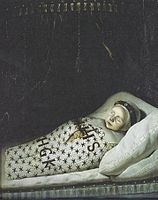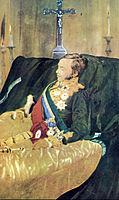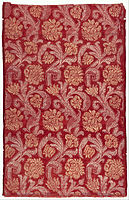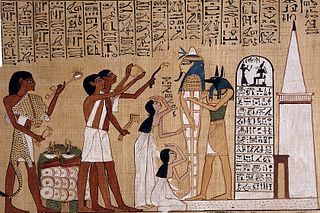
A funeral is a ceremony connected with the final disposition of a corpse, such as a burial or cremation, with the attendant observances. Funerary customs comprise the complex of beliefs and practices used by a culture to remember and respect the dead, from interment, to various monuments, prayers, and rituals undertaken in their honor. Customs vary between cultures and religious groups. Funerals have both normative and legal components. Common secular motivations for funerals include mourning the deceased, celebrating their life, and offering support and sympathy to the bereaved; additionally, funerals may have religious aspects that are intended to help the soul of the deceased reach the afterlife, resurrection or reincarnation.

Mary Tudor was an English princess who was briefly Queen of France as the third wife of King Louis XII. Louis was more than 30 years her senior. Mary was the fifth child of Henry VII of England and Elizabeth of York, and the youngest to survive infancy.

Mourning is the expression of an experience that is the consequence of an event in life involving loss, causing grief, occurring as a result of someone's death, specifically someone who was loved although loss from death is not exclusively the cause of all experience of grief.
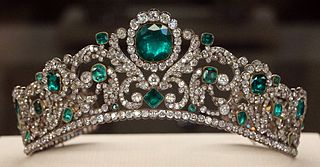
A tiara is a jeweled head ornament. Its origins date back to ancient Greece and Rome. In the late 18th century, the tiara came into fashion in Europe as a prestigious piece of jewelry to be worn by women at formal occasions. The basic shape of the modern tiara is a (semi-)circle, usually made of silver, gold or platinum, and richly decorated with precious stones, pearls or cameos.

A wreath is an assortment of flowers, leaves, fruits, twigs, or various materials that is constructed to form a circle.

Princess Helena Victoria of Schleswig-Holstein was a granddaughter of Queen Victoria of the United Kingdom. From 1917 her name was simply Princess Helena Victoria.

Kenau Simonsdochter Hasselaer (1526–1588) was a wood merchant of Haarlem, who became a legendary folk hero for her fearless defense of the city against the Spanish invaders during the siege of Haarlem in 1573.
Bereavement in Judaism is a combination of minhag (traditions) and mitzvah (commandments) derived from the Torah and Judaism's classical rabbinic literature. The details of observance and practice vary according to each Jewish community.

Post-mortem photography is the practice of photographing the recently deceased. Various cultures use and have used this practice, though the best-studied area of post-mortem photography is that of Europe and America. There can be considerable dispute as to whether individual early photographs actually show a dead person or not, often sharpened by commercial considerations. The form continued the tradition of earlier painted mourning portraits. Today post-mortem photography is most common in the contexts of police and pathology work.

Funerals and funeral prayers in Islam follow fairly specific rites, though they are subject to regional interpretation and variation in custom. In all cases, however, sharia calls for burial of the body as soon as possible, preceded by a simple ritual involving bathing and shrouding the body, followed by Salat al-jinazah. Burial is usually within 24 hours of death to protect the living from any sanitary issues, except in the case of a person killed in battle or when foul play is suspected; in those cases it is important to determine the cause of death before burial. In Islam, mourning for the deceased is observed for three days by the relatives.

Professional mourning or paid mourning is an occupation that originates from Egyptian, Chinese, Mediterranean and Near Eastern cultures. Professional mourners, also called moirologists and mutes, are compensated to lament or deliver a eulogy and help comfort and entertain the grieving family. Mentioned in the Bible and other religious texts, the occupation is widely invoked and explored in literature, from the Ugaritic epics of early centuries BC to modern poetry. Held in high esteem in some cultures and times, the practice was vilified in others, such as the Chinese Cultural Revolution. Female professional mourners, called Rudaali, were common in many parts of India, especially in the Western Indian state of Rajasthan.

Tangihanga, or more commonly, tangi, is a traditional funeral rite practised by the Māori people of New Zealand. Tangi were traditionally held on marae, and are still strongly associated with the tribal grounds, but are now also held at homes and funeral parlours. While still widely practised, tangi are not universally observed, and some tribes have expressed concerns about lower numbers of tangi.

The British grave of the Unknown Warrior holds an unidentified member of the British armed forces killed on a European battlefield during the First World War. He was given a state funeral and buried in Westminster Abbey, London on 11 November 1920, simultaneously with a similar interment of a French unknown soldier at the Arc de Triomphe in France, making both graves the first examples of a tomb of the Unknown Soldier, and the first to honour the unknown dead of the First World War.

The Black Brunswicker (1860) is a painting by John Everett Millais. It was inspired in part by the exploits of the Black Brunswickers, a German volunteer corps of the Napoleonic Wars, during the Waterloo campaign and in part by the contrasts of black broadcloth and pearl-white satin in a moment of tender conflict.

In the United Kingdom state funerals are usually reserved for monarchs. The most recent was the state funeral of Queen Elizabeth II on 19 September 2022.

Wybrand Hendriks was a Dutch painter, primarily known for his portraits, and the concierge of the Teylers Museum.

The death of Kim Jong Il was reported by North Korean state television news on 19 December 2011. The presenter Ri Chun-hee announced that he had died on 17 December at 8:30 am of a massive heart attack while travelling by train to an area outside Pyongyang. Reportedly, he had received medical treatment for cardiac and cerebrovascular diseases, and during the trip, Kim was said to have had an "advanced acute myocardial infarction, complicated with a serious heart shock". However, it was reported in December 2012 by South Korean media that the heart attack had instead occurred in a fit of rage over construction faults in a crucial power plant project at Huichon in Chagang Province.

Ancient Greek funerary practices are attested widely in literature, the archaeological record, and in ancient Greek art. Finds associated with burials are an important source for ancient Greek culture, though Greek funerals are not as well documented as those of the ancient Romans.
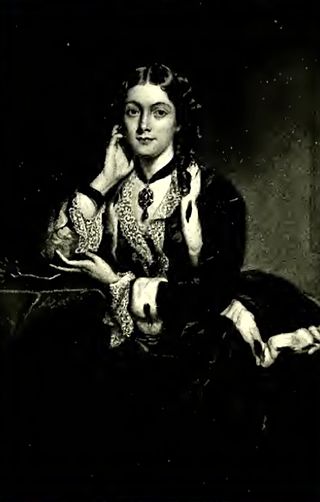
Caroline Stuart, Countess of Seafield, styled The Countess Dowager from 1884 to 1911, was a member of the Scottish aristocracy. She was proprietor of the Seafield Estates following the death of her son in 1884, and has been described as "The last of the great feudal chiefs".





